At Little Scholars, everything we do is guided by the four pillars that shape our philosophy: Learn, Grow, Inspire, and Contribute. These values are more than just words – they form the foundation of how we nurture children, support families, empower educators, and engage with our community. Each year, we honour four outstanding team members who bring these pillars to life through our annual ‘Pillar Awards’. This celebration recognises those who consistently go above and beyond – not only in their daily roles but in the way they lead, uplift others, and create a lasting impact.
While all our educators embody the spirit of Little Scholars, this year’s award recipients have stood out for their remarkable contributions in one pillar each – earning them the well-deserved title of our 2025 champions of Learn, Grow, Inspire, and Contribute.
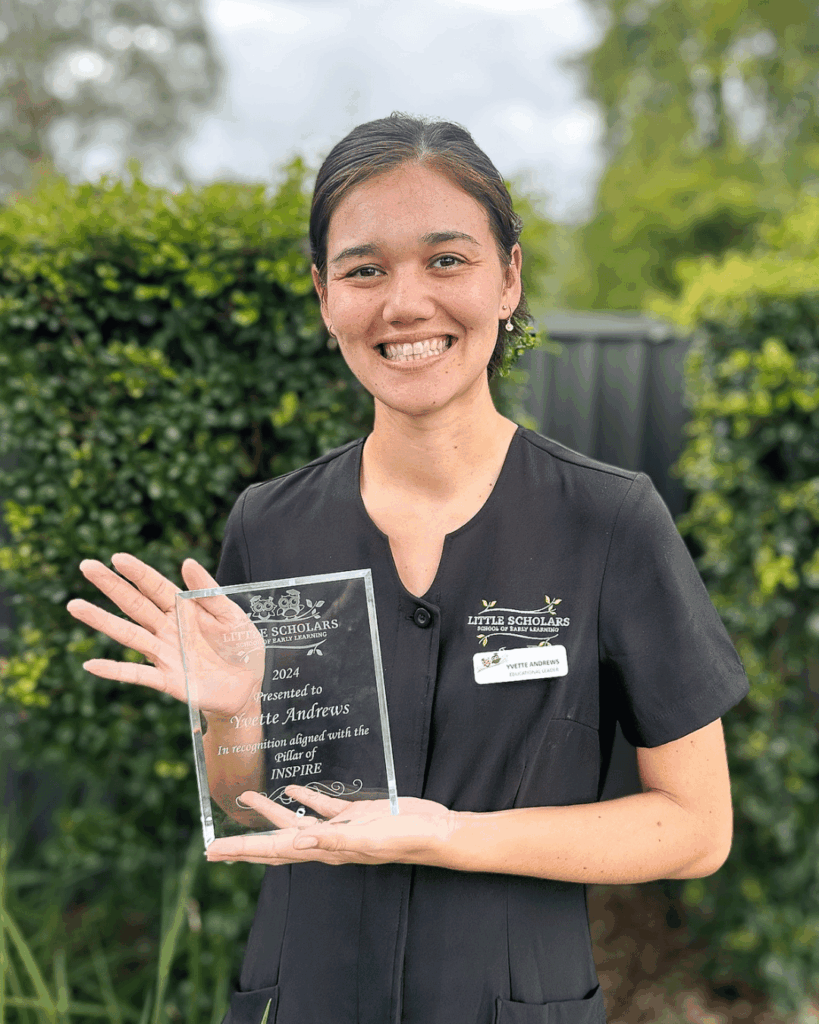
Yvette Andrews from Little Scholars Burleigh is the recipient of the ‘Inspire’ Pillar Award for 2025.
Yvette was nominated for her ability to lead with intention, encourage reflective practice, and consistently support those around her to think deeply about the impact they have on young children’s lives.
How long have you been an educator, Yvette?
I started in 2010 so have been working in early childhood for 15 years now!
What made you pursue a career in early childhood education?
To play! I was a really energetic 20 year old so I really just wanted to play with the children.
What does winning the award mean to you?
It reminds me that what I’m doing is meaningful and the effort I’m putting in isn’t going unnoticed.
What do you like about working for Little Scholars?
I get to work in an environment with people I can make a difference with – building an environment where everyone wants to contribute and celebrate being amazing educators, and helping support amazing little humans.
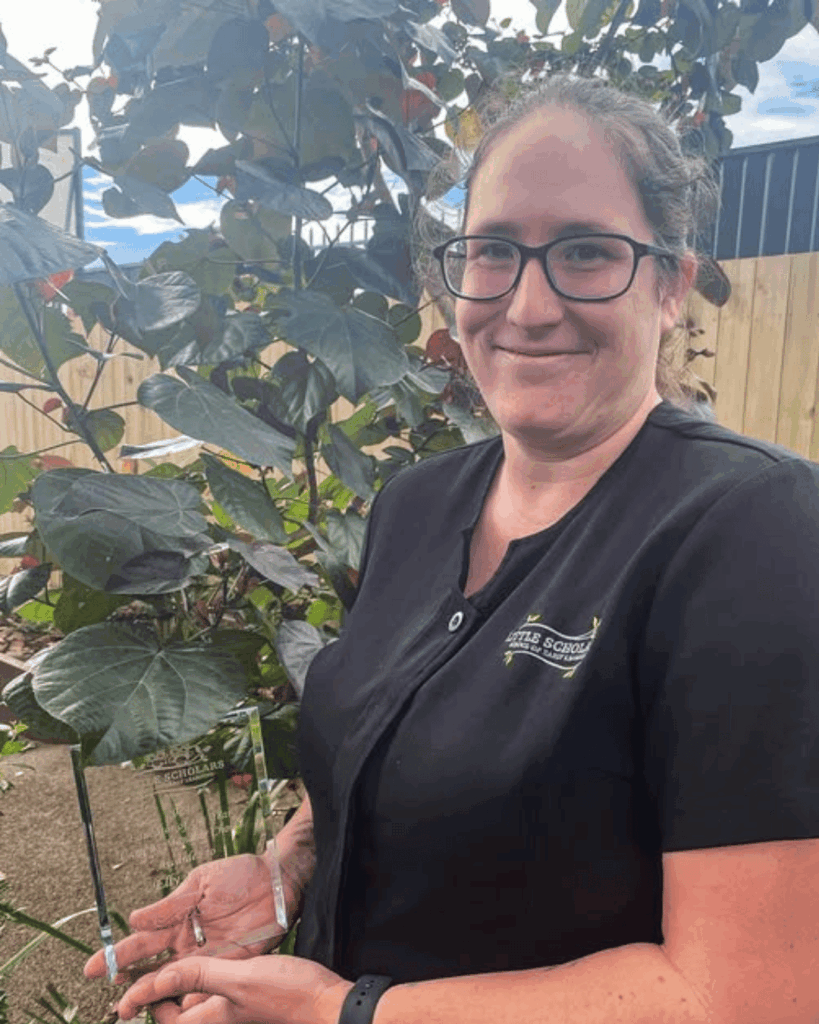
Hannah Megginson from Little Scholars Parkwood is the recipient of the ‘Contribute’ Pillar Award for 2025.
As a Lead Educator, Sustainability Officer, and now 3rd In Charge at Little Scholars Parkwood, Hannah consistently goes above and beyond, contributing not only to the care and education of children, but to the support of her team and the overall growth of her centre.
How long have you been an educator and how long with Little Scholars?
I have been an early childhood educator for 14 years.
What made you pursue a career in early childhood education?
I have always loved watching children learn and grow, they have such unconditional love for others and can be pretty funny too.
What does winning the award mean to you?
It means so much to be recognised for my hard work and commitment to the children that I care for.
What do you like about working for Little Scholars?
I get to work in an environment with people I can make a difference with – building an environment where everyone wants to contribute and celebrate being amazing educators, and helping support amazing little humans.
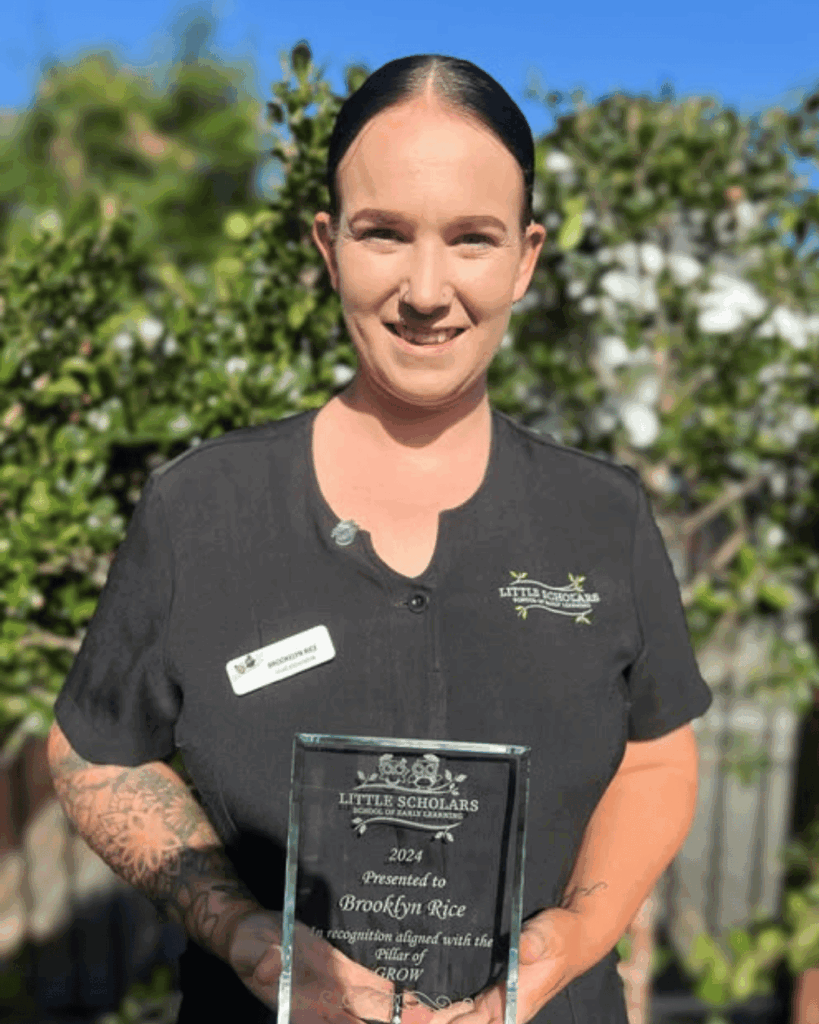
Brooklyn Rice from Little Scholars Pacific Pines is the recipient of the ‘Grow’ Pillar Award for 2025.
Brooklyn has shown incredible growth in her role as Lead Educator in the Senior Kindy room at Little Scholars Pacific Pines. Over the past six months, she’s transformed the space into a nurturing and engaging environment, supported her peers with openness and care, and built strong connections with families and children alike.
How long have you been an educator and with Little Scholars?
I started my educator journey 2.5 years ago with Little Scholars.
What made you want to become an educator?
I have a deep passion for helping children grow and develop. The ability to make a positive impact on their lives, guiding them through their early years and watching them blossom.
What does winning the award mean to you?
Winning this award means that my efforts and dedication have been recognised and appreciated. It serves as validation for the hard work, passion and care I put into my role as an educator. It’s not just about the recognition but the reminder that what I do truly makes a difference in the lives of the children I work with. It inspires me to continue growing, learning, and striving to be the best I can be.
What do you like about working with Little Scholars?
I enjoy working with Little Scholars because is aligns with my values and allows me to grow both personally and professionally. They are so supportive and there’s a shared commitment to making a positive impact on the lives of the children in our care. Working here also provides me with the opportunity to make a meaningful difference, knowing that I’m apart of something larger that values both education and the wellbeing of the children.
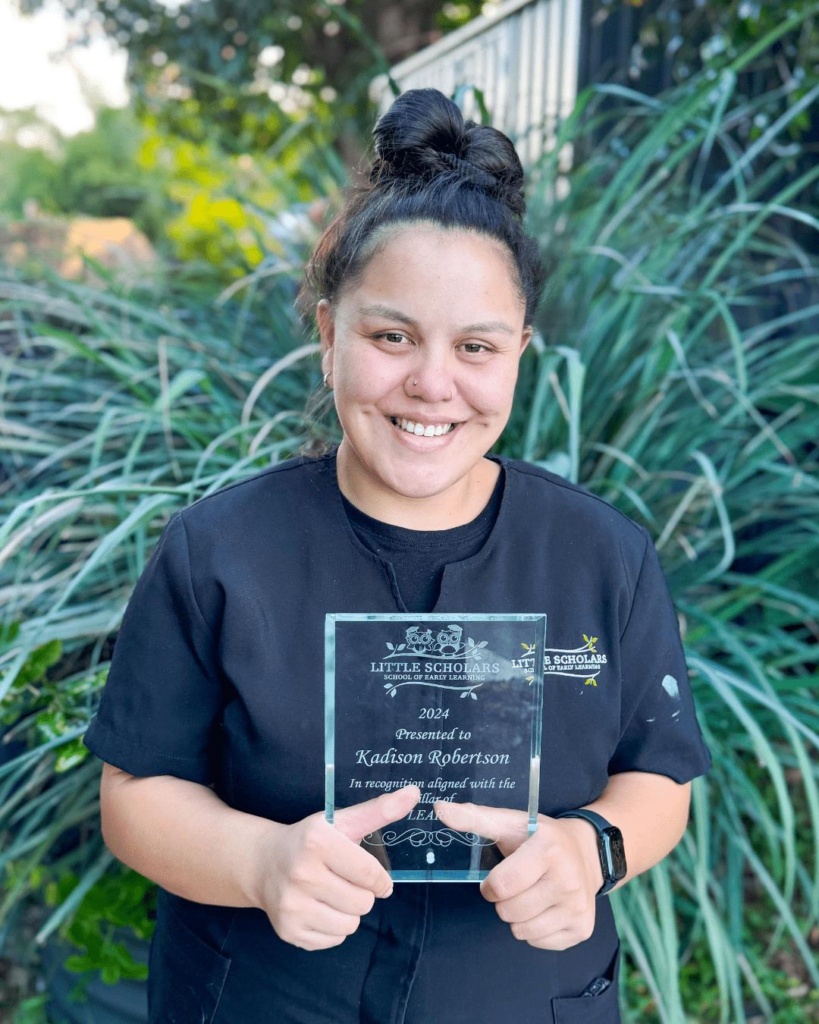
Kadison Robertson from Little Scholars Ashmore is the recipient of the ‘Learn’ Pillar Award for 2025.
Kadi is a seasoned educator whose extensive knowledge and experience make her a trusted source of wisdom and support. Always eager to engage in professional development, she consistently offers guidance and encouragement to those around her. Through her passion, others witness the true magic of teaching and learning through play.
We believe that if children learn early on how to recognise and regulate their emotions, we’re setting up a future of more empathetic, kind and respectful generation.
It’s so important, in fact, it’s a huge part of our Collective curriculum across all age groups. Our educators incorporate age and development-appropriate emotions learning opportunities throughout the year. Children who learn how to understand emotions in themselves and others are better able to regulate their own responses to strong emotions, helping them to move through that emotion and focus on all the other aspects of their lives!
There’s of course a number of reasons why emotional regulation is important to children’s development and wellbeing.
The early childhood years (o-5) have been identified in numerous studies as a crucial period for the development of important executive functions such as attention, inhibition, working memory, and literacy skills, all that are necessary for successful school transition and later academic success.
Even though this seems important, there hasn’t been much research on how emotion regulation affects young children’s academic performance. But we’ve found a couple of examples that highlight what we feel to be quite important in children’s development. Since academic skills tend to stay fairly stable over time, it’s essential to understand how managing emotions can support a successful start to school, especially in primary school.
Researchers have identified factors such as anxiety, aggression and verbal abilities as challenges that can affect children’s success in school, and furthermore relationships and career. One such study, The Role of Emotion Regulation and Children’s Early Academic Success, looked at how emotional regulation in young children can help with early academic success. Researchers identified that adaptive functioning, which refers to ‘numerous global positive outcomes including normative social, cognitive, and language development as well as the ability to cope with daily living tasks and environmental changes’ can be affected negatively or positively depending on children’s ability to succeed in school.
This particular study also emphasises that transition to school. Children enter a school environment where they are expected to learn important skills like reading, maths, and socialising. At the same time, they may receive less one-on-one support because of larger class sizes and a greater focus on their independence. Adjusting to these new academic and social demands, without the extra support they may have had in an early learning setting, can be challenging for many young children.
Another study, The Development of Self-Regulation across Early Childhood, highlighted that children who learn how to understand emotions in themselves and others are better able to regulate their own responses to strong emotions.
That’s where we come in!

At Little Scholars, we believe helping children recognise and name their emotions is an important first step in developing emotional awareness. This approach is also supported by the Early Years Learning Framework, which encourages children to build a strong sense of identity.
One example from our campuses is the use of a much-loved book, The Colour Monster by Anna Llenas. This story helps children identify different emotions through colours. After reading the book, our educators extend the learning with creative activities that use colour and storytelling as tools for emotional recognition. These experiences help children build healthy emotional responses and support their overall wellbeing.
Our campuses also incorporate songs and affirmations as part of their routines to reinforce children’s understanding of feelings, and help them figure out what works for them in regards to regulating those feelings.
We also actively participate mindfulness activities into our days to help children process and manage big emotions. Along with songs and affirmations, we use our sector-leading Bush Kinder program to get children out into nature, as well as deep breathing exercises, meditation and yoga as helpful ways for children to slow down, reset, and navigate their feelings.
At Little Scholars, our goal is for our services to be a welcoming second home for children where they can focus on learning through play, and our educators to be a source of comfort and trust for these wonderful little people. We offer calming zones both inside our studios and in our outdoor environments to allow children to escape and rest when they need a break.
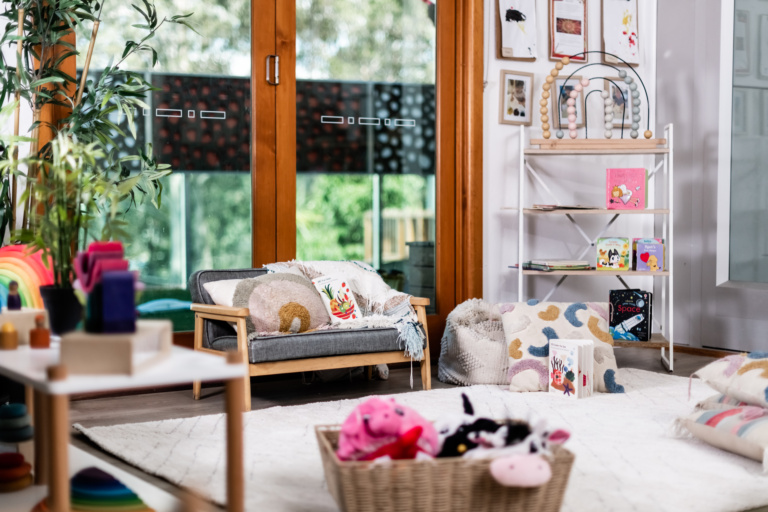
Our hope is the foundations we’re setting in children’s emotional and social development in those crucial first five years of development can be built upon in all stages of their childhood and beyond.
At Little Scholars, we’re focused on the holistic growth of each child in our care, by helping these small humans grow into kind, empathetic little legends who are ready to take on the big wide world. Book a tour at one of our 17 locations across the Gold Coast, Redlands, Brisbane and soon Ipswich to see how we incorporate social and emotional growth into our learning curriculum!
Did you know only about a quarter of Australian children aged 0-4 years regularly participate in organised sport and physical activity?
We all know regular exercise is important for maintaining good health, but we believe it’s even more important for little ones, not only for their health right now, but their optimal physical, emotional and brain development, and to form lifelong good habits for physical activity! The daily recommendation for children each day for physical activity ranges, so here we’ll break it down by age:
Infants (Birth to 12 Months)
Even before they start moving, babies should be active multiple times a day. This can include supervised floor play, reaching and grasping for objects, and at least 30 minutes of tummy time throughout the day while awake. Once they become mobile, activities like crawling, pulling up on furniture, and eventually walking (if ready) help build strength and coordination. Creating simple obstacle courses can encourage movement in a fun way.
Toddlers (1 to 2 Years)
Toddlers thrive on active play and should have at least three hours of physical activity each day, spread throughout the day. This should include energetic movement like running, jumping, twirling, skipping, and dancing. Playing tips, ball games, or setting up fun obstacle courses at home or in the park are great ways to keep them moving. The focus should be on making activity fun and encouraging exploration.
Preschoolers (3 to 5 Years)
Preschoolers also need at least three hours of activity daily, with at least one hour of energetic play. Running, jumping, throwing, kicking, skipping, and dancing all help develop coordination and strength. Activities should be spread across the day and designed to be enjoyable, encouraging curiosity and movement through play.
At Little Scholars, we ensure children are getting the recommended amount of physical activity each day in a number of ways!
Our extracurricular program includes a number of active offerings, including dance, soccer, swimming, sport and yoga, all designed and led by experts in their field who are specialised in child development to ensure these extracurriculars are getting heart rates up, improving coordination, building muscle as well as fine and gross motor skills, and most importantly, are fun!
Our outdoor Bush, Beach and Pram Kinder programs are thoughtfully planned to make the most of a child’s time outside. This means walking on uneven ground, climbing rocks and trees, picking up sticks, running and jumping. Even our little ones in prams are given time on grass or sand to crawl or enjoy tummy time on different surfaces providing new challenges to developing strength.
Our outdoor environments are designed to allow for sport, climbing, running, jumping, risk-taking, and other physical challenges! Not only do we have fantastic fort in each of our outdoor spaces for each age group, we have a range of other moveable equipment to help children build coordination and muscle such as climbing frames and trestles, bicycles, trampolines, balance beams and stepping stones.
At Little Scholars, we’re focused on the holistic growth of the whole child, not just building those rapidly developing brains, but ensuring we’re helping these little bodies grow strong and capable, all while learning valuable skills through play. By encouraging regular movement and active play, we’re helping children develop lifelong healthy habits. Whether it’s running, jumping, climbing, or dancing, every movement helps children grow in confidence and ability. We believe in creating an environment where children can thrive physically, mentally, and emotionally through play and learning.
Book a tour at one of our 17 locations across the Gold Coast, Redlands, Brisbane and soon Ipswich to see how we incorporate physical activity into our learning curriculum!
Why we should encourage risky play in early childhood
The importance of outdoor play for children’s development
How mindfulness enhances child development
The best playgrounds on the Gold Coast, Redlands, Logan and Brisbane
Introducing solids is an exciting milestone for you and your baby! Around six months of age, most babies are ready to explore new tastes and textures alongside breastmilk or formula. At Little Scholars, we support families through this journey, whether you choose purees or baby-led weaning with soft whole foods.
Most babies show signs of readiness for solids around six months. Look for these cues:
Sitting up with minimal support
Showing interest in your food
Opening their mouth for a spoon or reaching for food
Losing the tongue-thrust reflex (pushing food out of their mouth automatically) Though as babies begin to take in food, this instinct may remain until they get used to it.
Whatever way you approach the first tastes, go slow and offer just a couple of teaspoon-sized portions at first. Hand them a spoon to let them hold, though they’ll likely just eat (squish) with their fingers
You can start by offering food once a day alongside their normal amount of breast milk or formula, then work your way up over the coming weeks to three or more feedings a day.
To help babies adjust to the unique tastes of foods, one approach we like starting with vegetables for the first 14 days, one new, iron-rich vegetable each day. This helps develop a taste for nutritious foods before introducing fruit or other sweet flavours, as they’re already accustomed to sweet flavours through formula or breast milk.
Queensland Health recommends including iron-rich foods every day to help baby grow well, such as lean meat and legumes, baby cereal with iron, and green leafy vegetables. Of course, you’ll need to work up to these denser foods. It’s also recommended to introduce nuts into diets soon, as this can help reduce allergies. However please note we do not offer nut products at our campuses.
We support both traditional purees and baby-led weaning (BLW). Here’s how they differ:
Purees: Smooth textures, spoon-fed by a parent or educator, with gradually thicker consistencies over time.
Baby-led weaning: Soft, whole foods in safe shapes that babies can pick up and feed themselves, encouraging independence and coordination.
Regardless of your approach, always supervise your baby while they eat and offer soft, easy-to-swallow foods. At our campuses, babies are closely supervised during meals and snacks, but we also use these as opportunities to bond, having lots of fun interactions and conversations with our little ones while they eat!
Offer solids when your baby is alert and in a good mood
Start with small amounts. A teaspoon or two is plenty at first
Encourage exploration. Expect mess, it’s part of the learning process!
Be patient. Some babies take time to adjust to new textures
Watch for allergies. Introduce new foods one at a time, leaving a few days in between common allergens like eggs, dairy, or nuts.
At Little Scholars, we help families introduce solids in a way that works for them. Our educators can support your baby with purees or baby-led weaning while ensuring meals are safe, nutritious, and enjoyable. We work closely with families to understand preferences and keep you informed about your baby’s progress.
Starting solids is an exciting step in your baby’s development. With patience, variety, and support, mealtimes can be a wonderful experience for both of you!
We aim to be an extension of your family and are here to support you and your child during those important childhood milestones. If you’re in need of high quality early childhood education for your little ones in South East Queensland, book a tour today.
Babies are a mysterious bunch. For many months, their main forms of communication are cries, squeaks, gestures and coos. Parents fall madly in love with these little humans without knowing what they’re thinking and feeling, often just guessing at best.
How babies play, how and what they’re learning, and what they’re interested in can be a mystery to many. Many parents have seen their baby pull out every book off a shelf, for example, watch it fall, then grab another, while that parent scratches his or her head and says ‘why?’
There’s an answer. It’s a schema. A schema is both a category of knowledge as well as the process of acquiring that knowledge. In play, babies are often involved in repeated actions or certain behaviours as they explore the world around them and try to find out how things work. Those repetitive actions, such as a baby pulling out book after book, allows a child to practice and construct meaning to something, until they’ve understood that schema. Then they find something else to focus on and lather, rinse, repeat!
As Yvette, educational lead from our Burleigh campus says, it’s children’s development making sense.
“All of those little things that you see children do that seem a bit cute, or frustrating even, like throwing, it’s a schema, a child’s pathway of development for making sense of the world,” Yvette says.
The repetitive action of a schema allows a child to practice and construct meaning until they have mastered the understanding of the schema. Being aware of play schemas helps in two ways:
There are a number of types of schemas when it comes to babies.
Trajectory schema – The trajectory schema is one of the earliest schemas observed in babies. They are fascinated with how they, and objects move. Children will often throw objects or food from their pram or highchair. They climb and jump in puddles and enjoy exploring running water.
Transporting schema – Little ones enjoy repeatedly moving resources around, from one place to another. They will carry many items at a time using their hands, pockets, containers,
baskets, bags, or anything else that will hold their newfound treasures.
Enclosing schema – Children show an interest in enclosed spaces. They may want to sit (and hide in) boxes or laundry baskets. Or they may show interest constructing fences and barricades to enclose toy animals or themselves.
Rotational schema – Children showing a rotational schema may display a preference for turning taps on and off, winding and unwinding string, and playing with
hoops. They may also be fascinated with the physical experience of twirling and twisting their body, spinning around on the spot, or rolling themselves down a hill. They have an interest in things that turn, such as wheels and windmills. They enjoy rolling tyres around, turning lids and watching the washing machine on a spin cycle.
Enveloping schema – Children with an enveloping schema are interested in covering and hiding items, including themselves. They will enjoy dressing up, and filling and emptying bags and containers with different objects.
Connecting schema – Children displaying the connecting schema want to join items together. They find resources like string to tie things. They connect and disconnect toys such as rail tracks.
They enjoy construction toys, and doing arts and crafts where they can glue and stick pieces together.
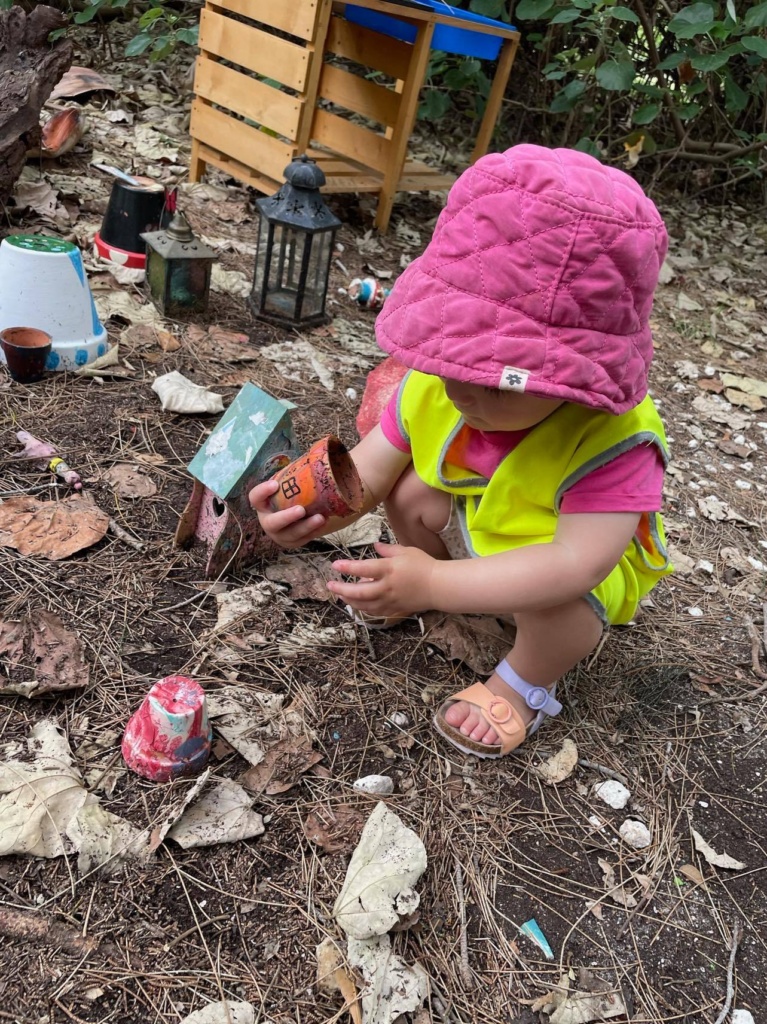
Orientation schema – Children like to turn objects and themselves around and upside down, to get a view from under the table or from the branch of a tree. They may bend over and look at the world backwards through their legs. They enjoy seeing things from a different view when exploring using cardboard tubes, binoculars or a magnifying glass.
By adapting this theory, we have been able to slow down and become more in tune to the children and noticing their behaviour patterns in play. It is now so important to us that we allow our babies and young children the time to explore the repetitive actions of schematic play.
-Jodie, lead educator
Jean Piaget was one of the first to use the term “schema” back in 1923. Piaget was an important child development theorist and his Theory of Cognitive Development was and still is read and followed today by early childhood specialists. He was one of the first who believed children think differently than adults and that they have an innate desire to learn and actively build up their knowledge about the world. They are not passive creatures waiting for someone to teach them.
Susan, our group pedagogical leader, is bringing her schema knowledge across our campuses to the lead educators in the nursery and toddler studios in 2023. Learn a bit more below about how we use schema theory, and how one educator has taken it on in her nursery.
Schematic Pedagogy
Through our collective curriculum, our educators are guided through a ‘schematic lens’, meaning they can plan for children’s thinking, not just activities. This has a strong link to our Collective Curriculum, our educational program for children.
The learning environment
Our educators apply teaching methodologies to design their play spaces and are intentional in the resources offered.
Observing and planning for children’s thinking
Through our collective curriculum, our educators observe the children through their play, to determine schemas explored through the children’s engagement to an activity or resource. Through observing patterns of learning, our trained educators can plan forward to scaffold their cognitive capabilities.
Partnering with children in play
Through ongoing mentoring and coaching, our educators are able use their knowledge of schemas and plan effectively. Our educators are encouraged to partner with children in their play and observe behaviours explored through schemas.
“Schemas are an intrinsic part of child development, knowledge to schemas provide our team of educators an opportunity to identify and encourage independence in children as they explore patterns of movement, often related to schemas,” Susan says. “Supporting assessing through a schematic lens, provides our educators with a framework which can be used to analyse children’s learning, supporting the planning process within our curriculum.”
You may be wondering if you have a baby or a small toddler in one of our campuses, how we use schemas to help their development. We talked to one of the educators at our Deception Bay campus about using schemas for educational programming. Deception Bay Little Scholars was recently rated as Exceeding the National Quality Standard (NQS) after it was assessed by the Department of Education. The NQS sets a high national benchmark for early childhood education and care in Australia. Jodie, lead educator in the nursery studio, says learning about schemas was a game-changer.
Both our younger babies and older babies really enjoy dropping objects or putting things in and out of containers (vertical trajectory). Using old formula tins and cutting an opening in the top with lids from jar foods a milk bottle lids, is a big favourite.
Our older babies are seen continuing with trajectory and begin to start exploring other forms of schematic play like, transporting, rotation, connecting and this can lead to a disconnecting schema where the child builds something that they can demolish or through [activities like] untying knots, as well as enclosing, positioning, enveloping and orientation, such as looking at things from different viewpoints like hanging upside down, looking through their legs, looking at things upside down. No wonder our little people are so busy and on the go all the time!
Thanks, Jodie!
Related:
Pedagogical Practices: Bringing new learning techniques to Little Scholars
So you’ve decided to send your child to early learning – how exciting!
For first-time parents, preparing for this new chapter involves more than just packing a backpack, it means understanding key essentials like the Child Care Subsidy (CCS). Navigating the CCS can seem daunting, but fear not! We’ve written a comprehensive guide to help demystify the process to help you understand how to maximise this support for your family’s benefit.
Here we explain everything you need to know about and to apply for CCS, making it easier for you to support your child’s educational adventure.
Did you know you can apply for the Child Care Subsidy (CCS) before you enrol your child in early learning?
Wait, what’s CCS? The Child Care subsidy is assistance to help families with the cost of childcare. Your child’s day in early learning is payable by a daily fee charged by the centre. The government may cover some of this fee, depending on your individual circumstances. This is what is referred to as the ‘subsidy’.
You may be eligible for the Child Care Subsidy if you meet a number of factors. The Child Care Subsidy (CCS) changed in July 2024 for families earning under $533,280. The percentage of CCS will vary depending on your family’s income, and the income limit to receive the maximum allowed CCS will increase as well. For families whose income is up to $83,280, you could receive up to 90% from the CCS toward your child’s daily fee.
If you have two or more children in care, subsequent children are eligible for a higher subsidy than the first child. For families who earn a total income of up to $141,321, those children will receive 95% from CCS off your daily fee.
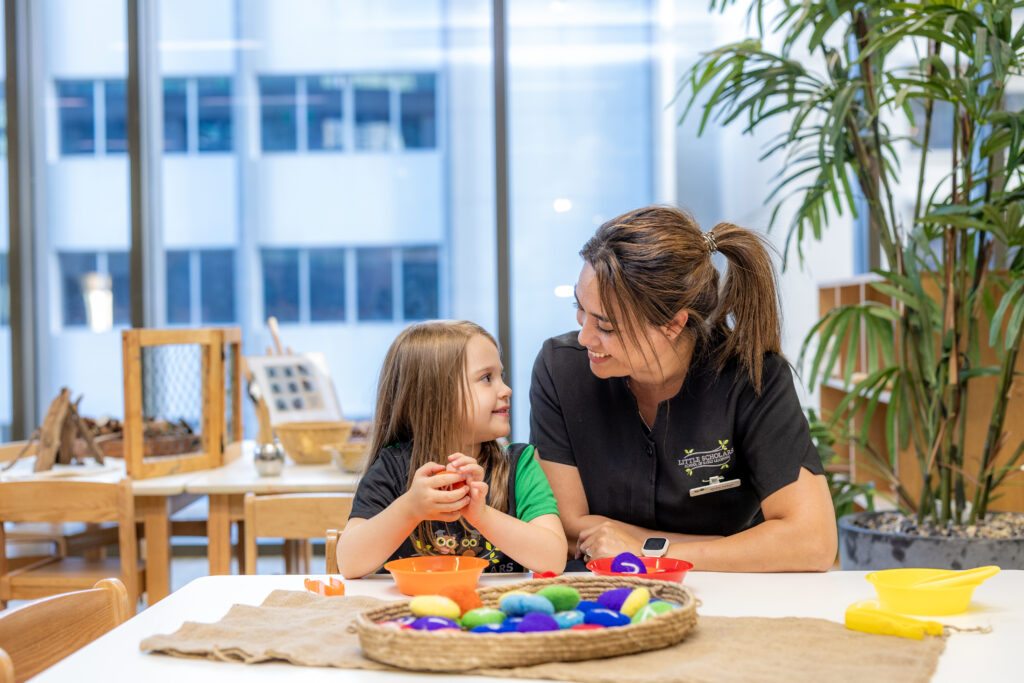
There are several requirements to qualify for the Child Care Subsidy. You may qualify if:
• You or your partner care for the child a minimum of two nights / fortnight
• You or your partner are responsible for childcare fees
• The child meets immunisation requirements
• You use an approved child care service like Little Scholars!
Once you’re ready for your child to go into early learning, you can apply for CCS!
The CCS works on three factors:
• Your total combined family income
• The service type. This can be long day care, or outside-hours care such as vacation care
• How much ‘work-related’ activity you and your partner undertake each fortnight This includes paid work, volunteering, study and other activities as determined by education.gov.au. Job hunting, studying, starting a new business, volunteering and travel time – among others – are all eligible activities that will allow you to claim subsidised hours of care.
Our website has a handy calculator you can use to get an idea of how much CCS you’ll receive.
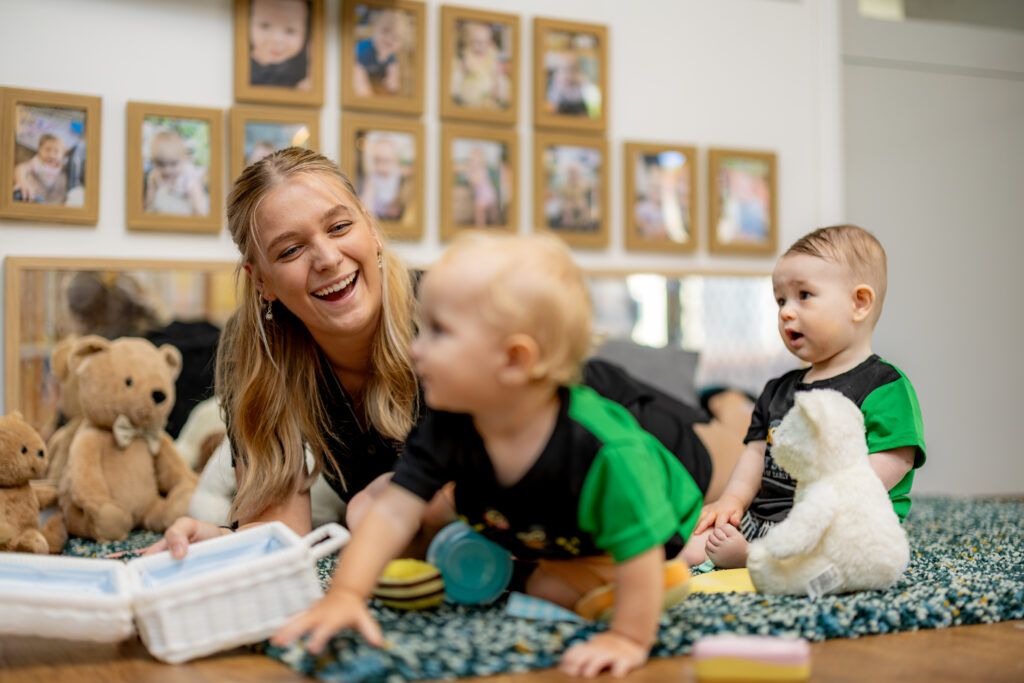
Apply for CCS via your MyGov Account, which is linked to Centrelink.
We recommend you do this as soon as you know when you might be sending your little one into early education and care, so it’s all set up and ready to go for your child’s first day. Don’t necessarily wait until you’ve enrolled with an early learning campus, because the entire process may take between four and six weeks, and if it’s not set up when you begin care, you may be paying full fees until it’s all complete.
Once your spot is booked in, confirm your Complying Written Agreement (CWA). When a CWA enrolment notice is created by the campus manager, there are two steps that need to be completed by the family:
1. You will be notified by email that the CWA is ready for you to agree to. A reminder will be sent via email should you not sign within 48 hours
2. Confirm your child’s government enrolment via MyGov. If you do not agree to the government enrolment, CCS cannot be paid.
During your Child Care Subsidy claim via MyGov, expect Services Australia to request a variety of documents to verify your eligibility. These may include financial details like bank account information, tax file numbers, and insights into your assets. Academic records, work-related documents like tax returns or pay slips, details about your living situation, relationship specifics, any international residence proofs such as visas, documentation regarding your children, and any relevant medical records are also crucial. Now that you know what to expect, we’d suggest these are prepared in advance to streamline your claim process.
Finally, we know change can be scary, overwhelming or confusing, as much for our parents as our little ones. We’re here for you from the day you book your tour to the day your child finishes their last day of kindergarten. We can absolutely help you navigate the CCS and other documents you need to help your child become a little scholars. Reach out to your campus manager, admin or any of the leadership team for guidance or further questions.
You’re having a baby! Congratulations! It’s such a thrilling time! But it can also be intimidating, stressful and overwhelming thinking of all things you need to think about and prepare for, before your child even arrives.
Or perhaps you have that sweet child, and while many take a leave of absence from work after baby is born, at some point families have to make the decision if and when they will return to work. That’s when you have to look at early learning and care for your children. Overwhelmed? We’re here to guide you and make life just a little bit easier.
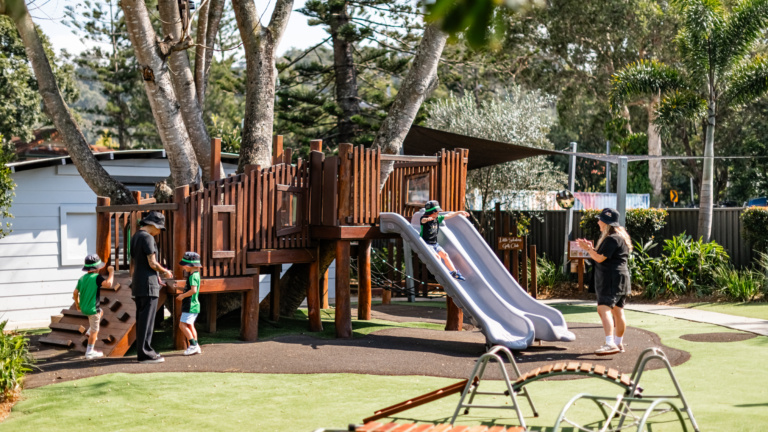
There are several options. Consider what early learning services are nearby and how far you’re willing to travel to drop-off and pick-up. You could even do it during peak hour traffic to get a better idea of how long it might take to get to these locations.
Check out the websites dedicated to listing early learning services such as Starting Blocks, Australia’s free government website dedicated to early childhood, the National Children’s Education and Care Quality Authority (ACECQA) national register or sites like Careforkids.com.au – which share services by location, including pertinent information such as assessment and rating outcomes, what each service offers, contact information and more.
Then, visit websites and start making some calls and book tours. That will be the best way for you to get ideas on philosophies, curriculums, learning and play environments, and they can answer any questions you may have.
Early learning and care providers in Australia have strict educator-to-child ratios, which is for the safety and benefit of both children and their educators, but that can mean spots fill quite quickly in each age and development learning environment, and in high-demand areas, waitlists can fill up quickly. However, don’t let us scare you, many high quality services have spaces available when you need them.
While this sector is thrilled to be able to allow more parents to continue or join the workforce, that does mean demand will be higher for quality early learning and care.
Start early. Contact the campus you’re interested in to see if there is indeed a wait list. Ideally, get names on wait lists at least six months to 12 months before you need care. Often, services will be considering what spots are available for the next year toward the end of the year – October to December. That doesn’t mean if you need care in May that you’re out of luck, but for busy services, thinking of the first of the year as a start time might be realistic. Sometimes, families get their unborn babies on wait lists just to be sure. At Little Scholars, if this is the case for your family, we’ll contact you about one month after your due date to see where your family is with thinking about care for your new addition.
Visit the service before joining the waitlist. Most early learning locations offer tours, you just need to book them in advance to avoid disruption and guaranteeing someone will be able to provide you the time you need to get a feel for the service.
Keep in contact with the service to see how your child is progressing on the wait list.
Some services offer places to families who have been on the waitlist the longest. Some may place internal families first, meaning families who already have a child in their care and are adding additional children. Some services may have a strict “first-in, best-dressed” approach. It’s worth asking what the policy is.

In early learning, a “ratio” refers to the comparison between the number of educators and the number of children they are responsible for supervising, essentially showing how many children each adult is looking after at a given time; it’s a crucial aspect of ensuring children’s safety and wellbeing in an early childhood setting, with different age groups often having different required ratios depending on their developmental needs.
The ratio for our children is as follows:
These ratios adhere to the requirements of the National Quality Framework.
The Child Care Subsidy (CCS) is a government initiative designed to help families manage the cost of early learning. Your child’s time in care is charged as a daily fee by the service, and the government may cover a portion of this cost based on your individual circumstances. This is known as the subsidy.
You can apply for the Child Care Subsidy (CCS) even before enrolling your child in early learning, in fact as long as your child has a birth certificate, you can apply. You then have 13 weeks to activate your CCS with an early learning service. If that time lapses, you can go online to reactivate it.
We have a helpful webpage dedicated to everything you may need to know about CCS!
The benefits of placing small children in early childhood education are numerous. Early learning can help babies develop social skills, motor skills, and cognitive abilities. Because of course, learning doesn’t start when a child begins school, it begins at birth!
Social development
Babies can begin forming connections, learning to share, and developing early communication skills in a supportive environment.
Motor development
Early learning settings provide safe opportunities for babies to explore movement, such as reaching and grasping. These experiences help strengthen motor skills, with research suggesting that babies who engage in active exploration may reach developmental milestones earlier.
Cognitive growth
Exposure to a variety of learning experiences supports cognitive development. Studies indicate that children who participate in early learning programs may develop stronger cognitive abilities compared to those who do not.
School readiness
Early learning helps children prepare for kindergarten by teaching them to follow instructions, interact with peers, and adjust to time away from their parents.
Academic success
Research shows that early education programs can contribute to improved academic achievement in children.
Little Scholars and most early learning services will suggest to parents that they enrol their children at least two days every week in care. Why? Nearly a quarter of Australian children start school without the foundational skills they need in areas like communication, social skills, emotional wellbeing, and physical health.
Attending for at least two years, with a minimum of 15 hours per week, is linked to better literacy and numeracy outcomes that persist into adolescence. High-quality early learning also supports secure attachments with educators, helping children settle and understand routines, and engage more actively with peers.
In our learn and play studios, At Little Scholars, we provide tailored, age-specific early learning and childcare across four key stages: nursery, toddlers, pre-kindy, and kindy. Our expertly designed programs cater to the unique needs and developmental milestones of each age group. Our children learn through play, reflected through our dedicated early learning curriculum.
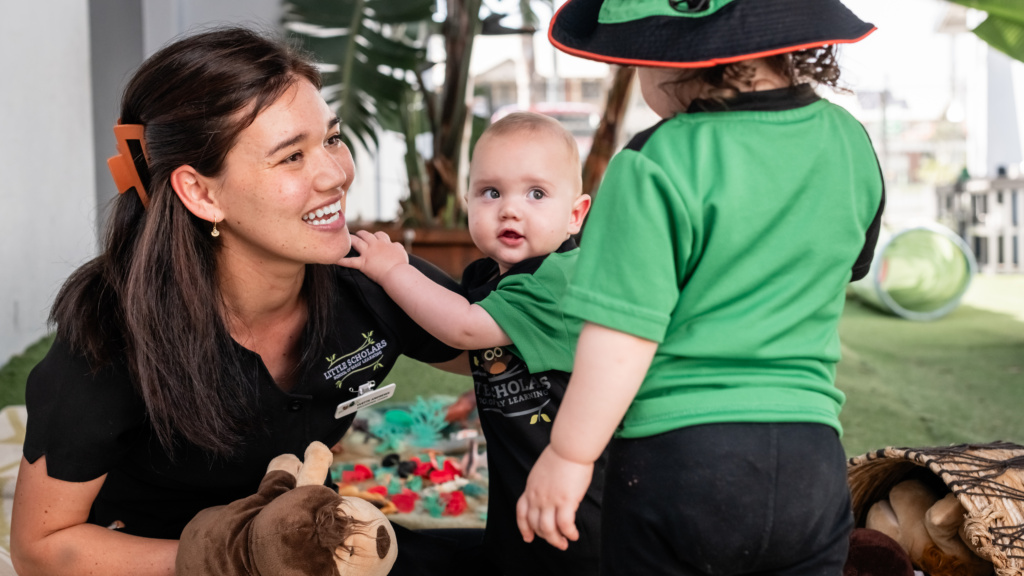
We understand the bonds young children have with their parents or caregivers. There is no denying that it may not be a smooth process, but we encourage parents to remember all the benefits children gain from attending early learning. Research also proves that having a child in care doesn’t negatively affect the bond with his or her main caregivers.
If you have a little ones who you think may struggle with separating from parents, check out our blog post: Tips and tricks for dealing with separation anxiety
If you as a parent are struggling with feelings of being away from your baby, we have a blog post for you in which we spoke with a clinical psychotherapist for her suggestions: Children aren’t the only ones who deal with separation anxiety
We very much welcome you to chat with us if you or your little one are or may deal with these feelings. You’re not alone and we can support you both through this transition.
If you have any questions or concerns about your child, we have an open door policy and we invite you to talk to your educator, educational leader or campus manager any time.
Little Scholars offers you and your child the very best facilities, resources and early educational, play-based programs available, which are underpinned by the early years learning framework. Our belief is that through quality education and care for children we can also encourage, assist and support the entire family.
Our dedicated team of educators are committed to the individual needs and interests of children and their families, and thus we encourage and welcome family input and involvement.
We aim to be like an extension of your family and are very relationship-driven. We support nurturing relationships between our educators and your child, the relationships your child has with the other children who attend, and we value our relationship with you as the parent and other family members. So book a tour today to get started!

Are you looking for low-cost options to help the family stay cool this summer? The Gold Coast is home to a host of free or low-cost, family-friendly swimming spots that are sure to cool everyone off and provide hours of fun entertainment. Here are 8 spots to try this summer, from the northern most parts of the Gold Coast, right down to the southern Gold Coast.
Lions Park is located at the Jacobs Well Boat Ramp, and is a council-managed, netted swimming enclosure nearby the mouth of the Pimpama River. Here you will find a small sandy beach area with shade sails right up to the water’s edge, as well as barbeque and picnic facilities. This spot is great for younger children, as they can get a taste of the beach without large waves or long walks from the car to the water. Best visited at high tide, it can be a bit muddy at low tide.

Cabbage Tree Point is a small town just near Jacobs Well, with a boat ramp, small beach and Charlie Hammel Park. This is a great spot for the family to spend a morning – set up a picnic blanket under the trees by the ship-themed playground and enjoy a swim at the small, sandy beach. Again, being on the river this is best visited at high tide, but enjoyable all day long.
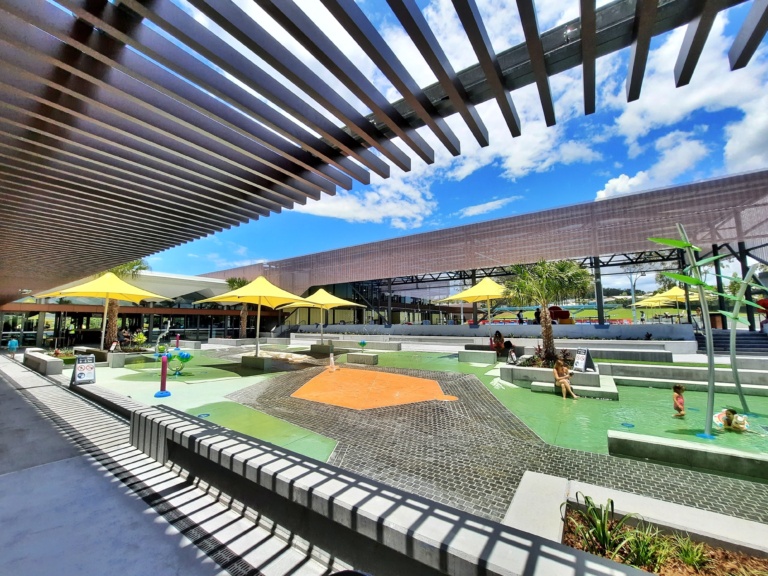
The Pimpama Sports Hub is the northern Gold Coast’s largest aquatic centre, with a 50-metre outdoor swimming pool, a 25-metre indoor swimming pool, learn to swim pool and a hydrotherapy pool. The children’s splash pad is exceptional, with water fountains, bubbling brooks and water at ankle depth – it’s ideal for toddler and primary school aged children.
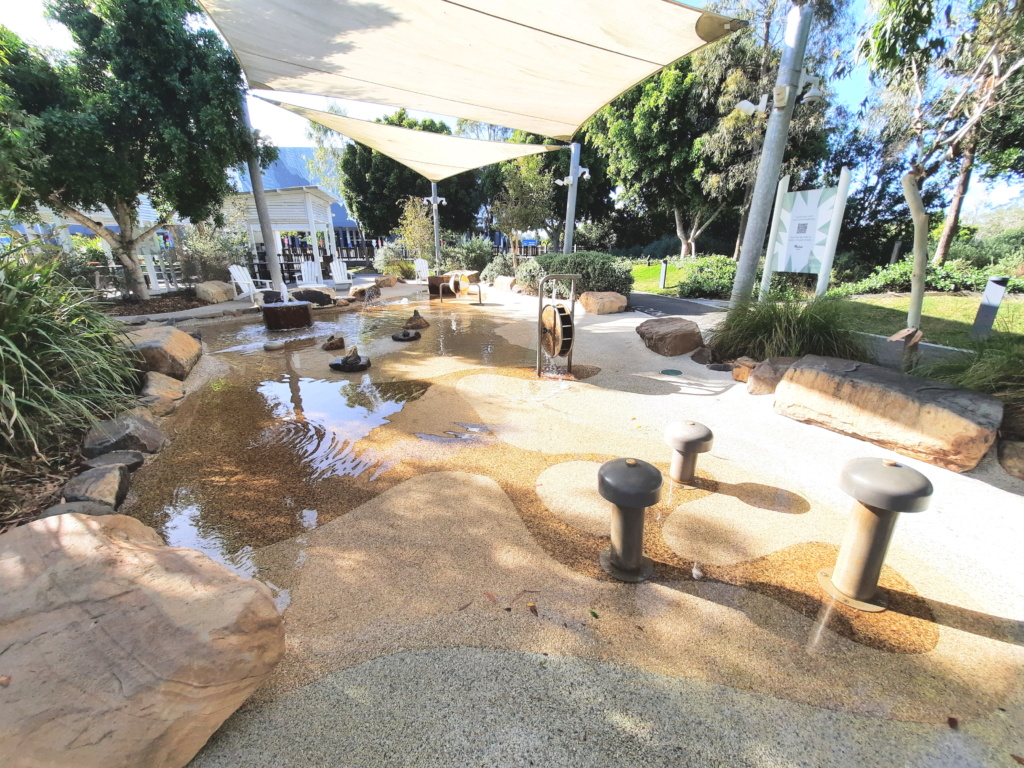
A splash pad might be the last thing you would expect to find at a shopping centre, but Westfield Coomera has one of the best free waterplay areas on the Gold Coast. Designed to resemble a billabong, waterways weave around interactive play stations where children can play with squirting frogs and jump across stepping stones. There are excellent change room facilities available and a café next door.

Ian Dipple Lagoon is a great place to go for a swim. Protected by a large sandbank, this lagoon is wave free and perfect for little ones. There are shower and toilet facilities along the shore as well, making the pack up easy. In the evenings, the lagoon is floodlit, so it’s also a great spot for dinner time fish and chips.
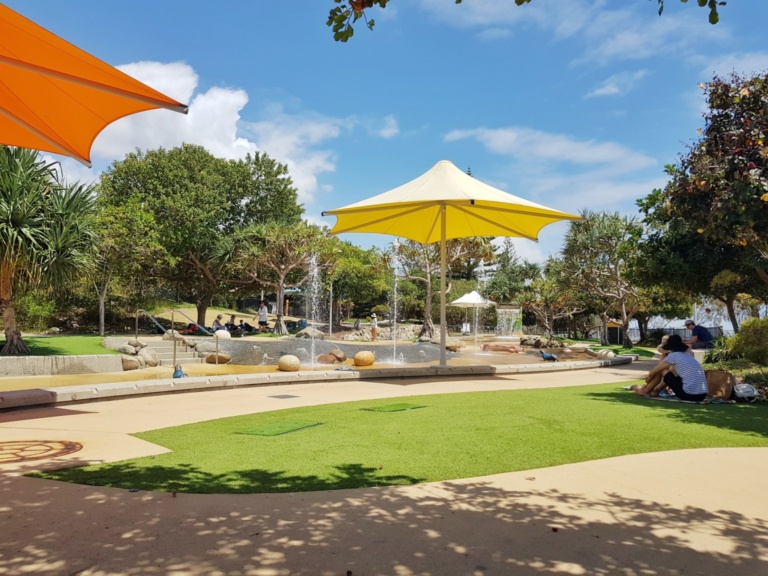
The Broadwater Rockpools might be the most popular water play space on the Gold Coast, with plenty of water fountains and vibrant marine-themed equipment to play with. The water play is built to resemble a creek bed, and it works like tidal rockpools with the water receding every 5-10 minutes and then returning again. The Rockpools are watched over by lifeguards during opening hours and it’s completely free to play.
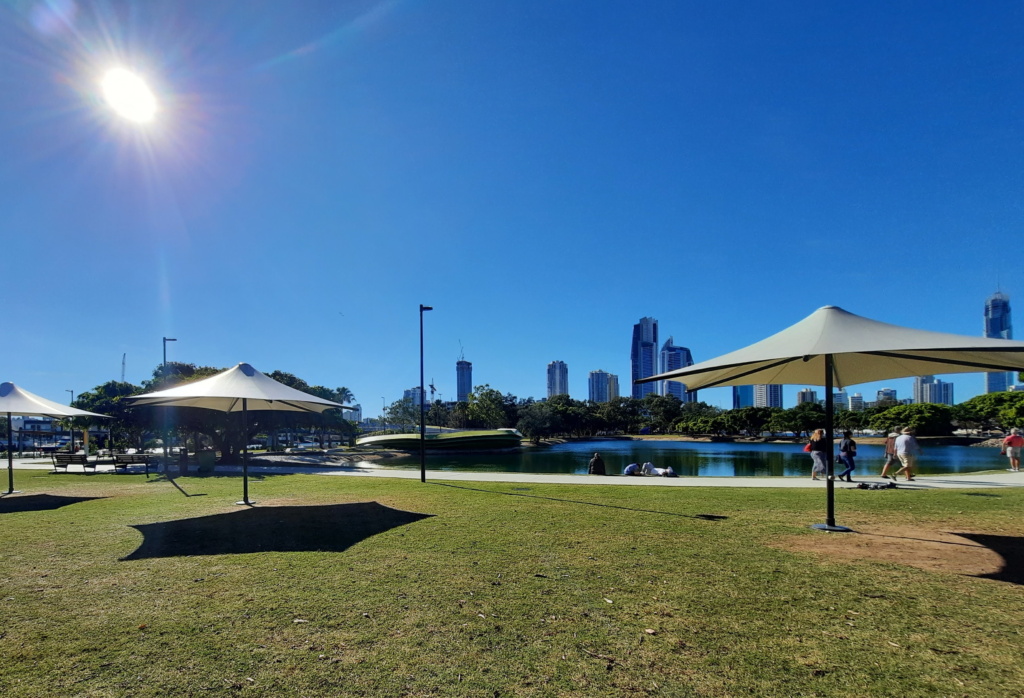
Located within the Home of the Arts precinct, Evandale Lake is a popular swimming spot for Gold Coasters. With a sandy beach around the outside, the lake has shallow edges but can be deceptively deep as you get further in. Families love to spend the day here, making the most of weekend food markets or a picnic lunch. There is a fun shaded playground by the lagoon too.
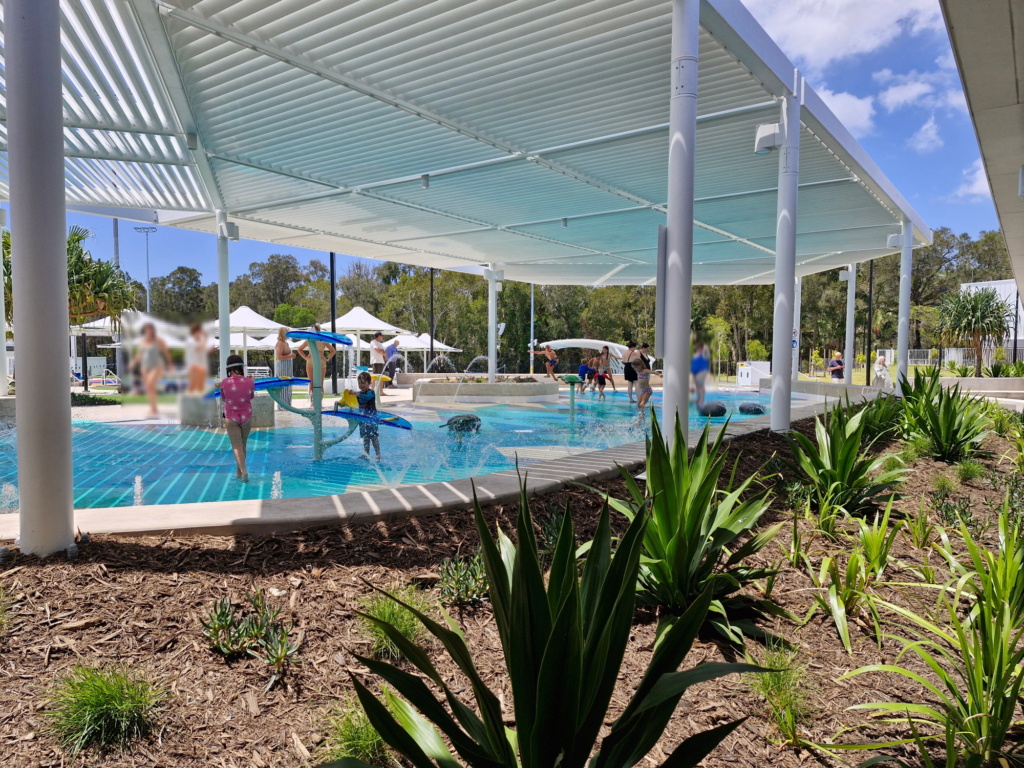
The newest water play destination on the Gold Coast, the Palm Beach Aquatic Centre opened at the end of October and now has a 50m outdoor pool, 25m outdoor pool, indoor warm water program pool, 25m indoor learn to swim pool, and an outdoor splash pad. The splash pad at Palm Beach is fairly simple in design, with plenty of sprayers along the ground as well as a few water play towers and spinners, but it is made entirely of a rubber base which is absolutely ideal for those crawling or learning to walk!
If you’re looking for early education and care for your young family, look no further than Little Scholars!
We offer your child the very best facilities, resources and early educational, play-based programs available, which are underpinned by the early years learning framework. We also believe in fun, wide-ranging experiences so that children can begin to develop interests and passions of their own, from Bush Kinder adventures to our broad extracurricular program which includes swimming for our kindergarten children, we believe in keeping wonder and magic in childhood.
Find Lara’s recommendations at her website Mrs. Lardeedah.com, and follow her socials Facebook and Instagram
Do you have a child who’s struggling with separation anxiety, especially at when being dropped off at school or early education? Perhaps they’re going through a developmental milestone that makes them need Mum or Dad a bit more than before. This is common starting around six months of age, peaks at 14-18 months, then can happen again when your child hits preschool and school-age. Or maybe your child is new to our service or has recently transitioned studios. The transition from home to early education is a milestone for both children and families. Separation anxiety can even happen for children who’ve been in Little Scholars for a while. It can be hard moving into a new studio where she or he doesn’t yet know new routines, where things are kept and spending time with different educators with different ways of doing things can be overwhelming for the child. This is all normal.
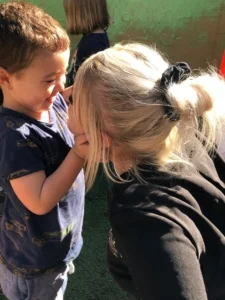
If you’re at a loss on how to make things easier on your little one, and yourself, we have some ideas.
Acknowledge and validate their feelings by saying something like “I know goodbyes can be hard, but I always come back. I will see you later today. I love you.” Give a big hug, a smile and a wink.
Then at home, if your child is old enough, have a chat about why she/he is having a hard time at drop-off, and think about what you can do to alleviate it. Ask him or her what make things easier. Perhaps it’s including a comfort toy, blanket or family photo. Maybe you each have a special bracelet that you can touch when you’re missing each other. Make a plan for something special together when you pick him or her up, like a walk or playing a game together, which will give your child something to look forward to through the day.
If you’re preparing your child to go to early education or school, it’s best they understand what their days will look like. So the conversation could look something like ‘we’ll all have breakfast together and get ready for the day. Then we’ll get in the car and first we’ll stop at Little Scholars. I’ll walk you in, give you a big hug, and you’ll go off to have a day of play while I go to work. When I finish work, I’ll jump in the car and come right over to pick you up, then we’ll go _____” These conversations may have to happen several times for it to sink in.
Also, if you’re pondering signing your child up for early education, this is why we offer play dates to children newly enroled but yet to start – this allows them to begin to become familiar with their new educators and studios.
Remember, you can always chat with your educator or campus manager about how to help. We’re always available, and we’ve been through this before, we can offer ideas or reassurances everyone will be OK!
We also know separation anxiety can be a two-way street, especially for new parents, or returning to work after maternity leave. Don’t forget we have our Little Scholars app so you can see pictures of your child, and be reassured that if there were tears from your child, they likely didn’t last long and they’re busy having fun and learning while you’re at work.
Related links:
Elizabeth Stone, an award-winning essayist and journalist, once captured the essence of parenthood with a poignant quote, ‘Making the decision to have a child – it is momentous. It is to decide forever to have your heart go walking around outside your body.’ This statement resonates deeply with many parents, astutely capturing the feelings of boundless love and the inevitable vulnerability that comes with bringing a child into the world.
This overwhelming surge of emotion is particularly intense during those initial moments and first days of separation from your child, often experienced when that child is entrusted to the care of someone else for the first time. It’s a milestone filled with mixed emotions for parents – pride in their growing independence, yet a deep longing to keep them close forever.
While the focus in the first few weeks at early learning facilities is generally on the children and how they’re settling in, an often-forgotten topic is the separation anxiety parents also can feel when they drop their little ones in care for the first time.
In childcare, we offer families tips on how to help children settle in, from suggestions such as: ‘don’t sneak away’, ‘keep goodbyes short’, and ‘maintain calm and confidence’, but what if the child is just fine, but the parents are struggling from the separation?
It’s understandable. If you’re coming off maternity or paternity leave, or perhaps you’ve been the primary parent at home for the last few years, change can be profoundly hard.
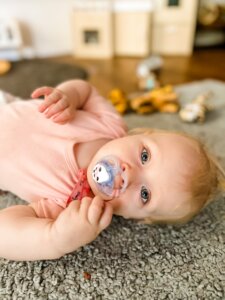
What we’re talking about is parental separation anxiety, and it’s more common than you think.
“I experienced separation anxiety with both my children when I dropped them into care for the first time, but I was much more surprised with my feelings the second time around,” says Christina, a communications professional who has two children. “I had to go back to work much earlier the second time around, and I felt a lot of grief for not getting to continue to bond with my son the way I had been, knowing he was my last baby. I also experienced some fears around him attaching to his educators more than me.”
A 2016 study by Pacey UK (the professional association for childcare and early years) reported that out of 1,000 mothers, 70% of mums said they worried about the extent they would miss their children, 90% reported feeling anxious about returning to work after having a child, while nearly half of mums admitted being very anxious.
How can parental separation anxiety manifest itself? Some of the more obvious signs are tears. Anxious feelings. Moodiness. While others you may not notice until they start affecting your life and mental health.
Here are some common indicators of more serious separation anxiety to be aware of:
Ask yourself, what is your biggest fear or worry in separating from your child? The initial step in overcoming these feelings is to acknowledge and understand them. If you’re experiencing heightened anxiety about being apart from your child, it’s important to explore the origins of these feelings. Perhaps they stem from experiences in your life in childhood, or birth trauma, the loss of pregnancy or another child, perinatal or postnatal anxiety/depression and existing anxiety issues, or it may simply be triggered by the act of becoming a parent.
“How does a parent reconcile these feelings of separating from their child? I think what’s important about that one is that often it’s around guilt,” says Sarah Bergman, a clinical psychotherapist at Counselling on the Coast who has more than three decades of experience in emotionally-focused therapy.
“Guilt is really an emotion that comes up when we have like an idealised sense of a situation or who we are. So we feel guilty when we don’t feel we’ve reached what we want to be reaching or we haven’t done what we want to do. I would say to explore those feelings of guilt, what they are, what you feel like you’re not doing for your child or getting right for your child.”
Sarah says those guilty feelings in parents often link back to situations in their own childhood where they felt like their own parents let them down. But the concern is also passing down those guilty or anxious feelings to your child.
“Their own wounds start to muddy the waters of the child’s experience. So the child’s just going to school, but then they feel their parents anxiety and then they also think that something’s wrong then too, which can make them anxious. So if the parents have a good look at themselves around, ‘what was it that my parents got wrong for me? or what was it that wounded me? and how does that now play across on my child?’ So the parents will often work hard to do the things that they don’t want that their children to experience themselves.”
While Sarah says often the guilty feelings stem from what they missed in their own childhood, the opposite could be true.
“Maybe [parents feel they’re] not meeting the ideals of what your parent did for you or what things that you really loved about your parent and now you feel like you’re not getting that right.”
Wherever the feelings stem from, Sarah says, parents may be trying to heal themselves through their relationship with their child. But, she says, a child doesn’t have those wounds. They don’t experience their parents in that same way that perhaps you did. So she surmises parents could be overcompensating for their own childhood pain.
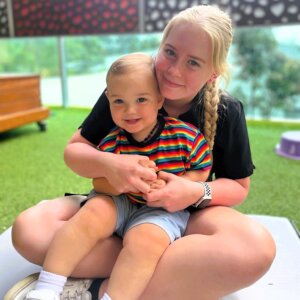
“Those kind of parents are very anxious at feeling like they have to attend to everything with their children because they don’t ever want their children to feel the way that they did,” Sarah summarises.
Consider jotting down your feelings or discussing them with a sympathetic friend or even a colleague who could relate with what you’re currently experiencing. Regardless of how trivial or illogical they might seem, allowing yourself to express and discuss these fears can aid in releasing them.
Making the decision to have a child – it is momentous. It is to decide forever to have your heart go walking around outside your body.
Elizabeth Stone
Sarah also suggests parents educate themselves on secure attachment, a theory first proposed by the British psychologist, psychiatrist, and psychoanalyst John Bowlby. For children, secure attachment to someone like a mum or dad allows them the secure base necessary to explore, learn and relate, and the well-being, motivation, and opportunity to do so. It’s important for safety, stress regulation, adaptability, and resilience and ultimately can help produce a happy, healthy well-adjusted child.
“If you are securely attached, you will feel less anxious because you will feel comfortable that you can trust, you have a positive view of other people and a positive view of self,” Sarah says. “So you think to yourself, ‘it’s okay. My child is in safe hands. They will let me know. I trust the daycare centre. And I trust myself that I’m doing the right thing by my child and it’s going to be okay and I need to go to work and this is just the way it is.’ Whereas someone who is more anxiously attached sometimes have a bit of a negative view of themself and possibly a bit of negative view of others so they don’t totally trust others, so it’s about trying to move into being more securely attached.”
She also says to have an honest conversation with educators or your campus manager.
“You know, that is actually good secure relating as well, that a parent can actually say, ‘I’m feeling a bit nervous’, or ‘I’m a bit worried about that,’ because they’re asking then, they’re not coping alone.”
Sarah recommends in that conversation, have a chat with educators or your campus manager about what might help to alleviate those anxious feelings, whether it’s a phone call or a text, a few extra pictures – whatever it is, having clear communication can help everyone.
“What helped me was an honest discussion with my son’s lead educator during a playdate. She asked me thoughtful questions about why I was having a hard time, asked how she could help alleviate those feelings for me, and was very mindful to update with lots of pictures, and even checked in on me at pick-up over the next few weeks. It was really helpful, and gave me feelings of trust in leaving my baby with her and her team,” Christina adds.
Those secure attachments we want children to have means we also want them to have bonds with others, such as loving educators.
A child who has had a secure attachment with her parent or another safe adult is more likely to be able to develop lasting successful relationships as an adult. In fact, a New York University study recently found positive, warm relationships between caregivers and children were associated with higher odds of attaining ideal heart health at multiple points across a 20-year span of adulthood, so developing these bonds is good for their health!
Part of early childhood training for educators is understand various child development theories such as attachment theory, so trust that your educators understand what secure attachments – both to parents and others children can trust – mean for children’s development and they work hard to ensure these bonds with your child.
Research has found our adult relationships are shaped by our early patterns of attachment and the ways we learn to deal with closeness and separation.
“Children are very attached to their parents and they love their parents very much. And that is who they want to be with. And if they create an attachment with someone else, that’s lovely. However, ultimately it’s important to keep in mind they will want to be with their parents,” Sarah says.
Sarah also says some of these feelings may be pressure we put on ourselves as parents.
“We don’t actually have to be perfect parents and I think a lot of people are really trying to be perfect parents and wrapping their children in bubble wrap. You just have to be good enough. I think from memory it’s only like around 60 or 70 per cent strike rate of meeting the child’s needs.”
Sarah is referring to the Winnicott theory.
“The good-enough mother is one who makes active adaptation to the infant’s needs, an active adaptation that gradually lessens, according to the infant’s growing ability to account for failure of adaptation and to tolerate the results of frustration.” – D. W. Winnicott, paediatrician and parent-infant therapist.
“We all have to learn that sometimes our needs aren’t going to be met. And that’s actually where we build resilience and we build understanding around that other people have things they need to do as well,” Sarah says. “You don’t have to drop everything to be there for your kids. It’s okay to have ruptures with your children. It’s actually okay because that is a realistic expectation on relationships. We all have ruptures and then we get to learn how to repair those ruptures. But of course, if the child’s fallen over or they’ve hurt themselves or they’re scared at night, you want your strike rate on those things needs to be closer to 100 per cent.
“But otherwise, we don’t have to be so hard on ourselves, we can get it wrong sometimes. We just go back and say, ‘Hey, I’m sorry I got that wrong.’ And then the child also learns that they’re going to get things wrong sometimes, too. They can come to their parent and say, ‘Hey, Mum, sorry about that.’”
If we can offer some advice, it’s what we also suggest to parents when children are having a hard time with separating. Find an activity you can do together outside of care hours that you can look forward to, so you can cherish your time together. Maybe after pick-up, you take your child for a walk or to the park, maybe it’s grabbing a sneaky ice cream after dinner, maybe it’s a game night or story time when you get home. Find ways to really connect with your child in the time you’re together may make the time you’re apart easier to deal with.
Sarah says mindful activities can help in easing anxious feelings. But, she says, if these feelings are taking over, it might be worth talking to a professional as soon as possible. You can talk to your GP about a referral to see a psychologist, or you can book in to a specialist practice such as Sarah’s Counselling on the Coast to have a chat with a psychotherapist.
Please remember, if Little Scholars can help in any way, we will, from offering a listening ear, to phone calls to whatever would help your family, we will. We’re not just here for children, we’re here for the whole family.
At Little Scholars School of Early Learning, we’re dedicated to shaping bright futures and instilling a lifelong passion for learning. With our strategically located childcare centres in Brisbane and the Gold Coast, we provide tailored educational experiences designed to foster your child’s holistic development.
Let us hold your hand and help looking for a child care centre. Leave your details with us and we’ll be in contact to arrange a time for a ‘Campus Tour’ and we will answer any questions you might have!
"*" indicates required fields
Let us hold your hand and help looking for a child care centre. Leave your details with us and we’ll be in contact to arrange a time for a ‘Campus Tour’ and we will answer any questions you might have!
"*" indicates required fields